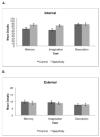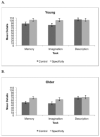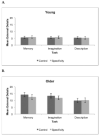Constructive episodic simulation: dissociable effects of a specificity induction on remembering, imagining, and describing in young and older adults
- PMID: 24188466
- PMCID: PMC4006318
- DOI: 10.1037/a0034885
Constructive episodic simulation: dissociable effects of a specificity induction on remembering, imagining, and describing in young and older adults
Abstract
According to the constructive episodic simulation hypothesis (Schacter & Addis, 2007), both remembered past and imagined future events rely heavily on episodic memory. An alternative hypothesis is that observed similarities between remembering and imagining reflect the influence of broader factors such as descriptive ability, narrative style, or inhibitory control. We attempted to distinguish between these 2 hypotheses by examining the impact of an episodic specificity induction on memory, imagination, and picture description in young and older adults. In Experiment 1, participants received the specificity induction or a control induction prior to the memory, imagination, and description tasks. Older adults provided fewer internal (i.e., episodic) and more external (i.e., semantic) details than young adults across the 3 tasks irrespective of induction. Critically, however, the specificity induction selectively increased internal but not external details for memory and imagination in both age groups compared with the control induction. By contrast, the induction did not affect internal (or external) details for picture description. Experiment 2 replicated these results in young adults using a different control induction. Our findings point to a dissociation between episodic processes involved in memory and imagination and nonepisodic processes involved in picture description.
PsycINFO Database Record (c) 2014 APA, all rights reserved.
Figures





Similar articles
-
An episodic specificity induction enhances means-end problem solving in young and older adults.Psychol Aging. 2014 Dec;29(4):913-24. doi: 10.1037/a0038209. Epub 2014 Nov 3. Psychol Aging. 2014. PMID: 25365688 Free PMC article. Clinical Trial.
-
Remembering the past and imagining the future: Selective effects of an episodic specificity induction on detail generation.Q J Exp Psychol (Hove). 2016;69(2):285-98. doi: 10.1080/17470218.2014.999097. Epub 2015 Feb 20. Q J Exp Psychol (Hove). 2016. PMID: 25529786 Free PMC article.
-
Remembering the past and imagining the future: attachment effects on production of episodic details in close relationships.Memory. 2018 Sep;26(8):1140-1150. doi: 10.1080/09658211.2018.1434800. Epub 2018 Feb 5. Memory. 2018. PMID: 29400595 Free PMC article.
-
Remembering the past and imagining the future in the elderly.Gerontology. 2013;59(2):143-51. doi: 10.1159/000342198. Epub 2012 Sep 13. Gerontology. 2013. PMID: 22987157 Free PMC article. Review.
-
The effect of episodic specificity inductions on cognitive tasks involving episodic retrieval: A quantitative review.Neuropsychologia. 2024 Jun 6;198:108884. doi: 10.1016/j.neuropsychologia.2024.108884. Epub 2024 Apr 9. Neuropsychologia. 2024. PMID: 38599568 Review.
Cited by
-
Episodic future thinking and episodic counterfactual thinking: intersections between memory and decisions.Neurobiol Learn Mem. 2015 Jan;117:14-21. doi: 10.1016/j.nlm.2013.12.008. Epub 2013 Dec 25. Neurobiol Learn Mem. 2015. PMID: 24373942 Free PMC article.
-
Memory Specificity Training for Depression and Posttraumatic Stress Disorder: A Promising Therapeutic Intervention.Front Psychol. 2018 Apr 3;9:419. doi: 10.3389/fpsyg.2018.00419. eCollection 2018. Front Psychol. 2018. PMID: 29666598 Free PMC article. No abstract available.
-
An episodic specificity induction enhances means-end problem solving in young and older adults.Psychol Aging. 2014 Dec;29(4):913-24. doi: 10.1037/a0038209. Epub 2014 Nov 3. Psychol Aging. 2014. PMID: 25365688 Free PMC article. Clinical Trial.
-
Enhancing memory and imagination improves problem solving among individuals with depression.Mem Cognit. 2017 Aug;45(6):932-939. doi: 10.3758/s13421-017-0706-3. Mem Cognit. 2017. PMID: 28405957
-
Remembering the past and imagining the future: Selective effects of an episodic specificity induction on detail generation.Q J Exp Psychol (Hove). 2016;69(2):285-98. doi: 10.1080/17470218.2014.999097. Epub 2015 Feb 20. Q J Exp Psychol (Hove). 2016. PMID: 25529786 Free PMC article.
References
-
- Adams C, Smith MC, Nyquist L, Perlmutter M. Adult age-group differences in recall for the literal and interpretive meanings of narrative text. Journal of Gerontology. 1997;52:187–195. doi:10.1093/geronb/52B.4.P187. - PubMed
-
- Addis DR, Pan L, Vu MA, Laiser N, Schacter DL. Constructive episodic simulation of the future and the past: Distinct subsystems of a core brain network mediate imagining and remembering. Neuropsychologia. 2009;47:2222–2238. doi:10.1016/j.neuropsychologia.2008.10.026. - PubMed
-
- Addis DR, Wong AT, Schacter DL. Age-related changes in the episodic simulation of future events. Psychological Science. 2008;19:33–41. doi:10.1111/j.1467-9280.2008.02043.x. - PubMed
Publication types
MeSH terms
Grants and funding
LinkOut - more resources
Full Text Sources
Other Literature Sources
Medical
Miscellaneous

